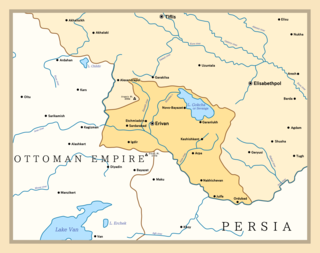Related Research Articles

The Macedonian dynasty ruled the Byzantine Empire from 867 to 1056, following the Amorian dynasty. During this period, the Byzantine state reached its greatest extent since the Muslim conquests, and the Macedonian Renaissance in letters and arts began. The dynasty was named after its founder, Basil I the Macedonian who came from the Theme of Macedonia, which, at the time, was part of Thrace.
Iranian-Armenians also known as Persian-Armenians, are Iranians of Armenian ethnicity who may speak Armenian as their first language. Estimates of their number in Iran range from 70,000 to 200,000. Areas with a high concentration of them include Tabriz, Tehran, Salmas and Isfahan's Jolfa quarter.

Russian Armenia is the period of Armenian history under Russian rule from 1828, when Eastern Armenia became part of the Russian Empire following Qajar Iran's loss in the Russo-Persian War (1826–1828) and the subsequent ceding of its territories that included Eastern Armenia per the out coming Treaty of Turkmenchay of 1828.

The Nakhchivan Khanate was a khanate that was established in Afsharid Persia in 1747. The territory of the khanate corresponded to most of the present-day Nakhchivan Autonomous Republic and Vayots Dzor Province of present-day Armenia. It was named after its chief settlement, the town of Nakhchivan.

The Erivan Khanate, also known as Chokhur-e Sa'd, was a khanate that was established in Afsharid Iran in the eighteenth century. It covered an area of roughly 19,500 km2, and corresponded to most of present-day central Armenia, of the Iğdır Province, Kağızman district of the Kars Province of present-day Turkey and the Sharur and Sadarak districts of the Nakhchivan Autonomous Republic of the present-day Azerbaijan Republic.

Davit Bek or David Beg was an Armenian military commander and one of the most prominent military figures of the Armenian liberation movement of the 18th century.

Barda is the capital city of the Barda District in Azerbaijan, located south of Yevlax and on the left bank of the Tartar river. It was the capital of Caucasian Albania perhaps since the end of the fourth century, Barda became the chief city of the Islamic province of Arran, the classical Caucasian Albania, remaining so until the tenth century.

The Armenian Oblast or Armenian Province was an oblast (province) of the Caucasus Viceroyalty of the Russian Empire that existed from 1828 to 1840. It corresponded to most of present-day central Armenia, the Iğdır Province of Turkey, and the Nakhchivan exclave of Azerbaijan. Its administrative center was Erivan (Yerevan).

George A. Bournoutian is an Iranian-American professor, historian, and author of Armenian descent. He is a retired Professor of History and the author of over 30 books, particularly focusing on Armenian history, Iran and the Caucasus. He has taught Iranian history at UCLA, and Armenian history at Columbia University, Tufts University, New York University, Rutgers University, the University of Connecticut, Ramapo College, and Glendale Community College and Russian and Soviet history at Iona College Bournoutian is one of the 40 editors of the Encyclopaedia Iranica as well.

Karabakh is a geographic region in present-day eastern Armenia and southwestern Azerbaijan, extending from the highlands of the Lesser Caucasus down to the lowlands between the rivers Kura and Aras.

The Bagratid Kingdom of Armenia, also known as Bagratid Armenia, was an independent state established by Ashot I Bagratuni of the Bagratuni dynasty in the early 880s following nearly two centuries of foreign domination of Greater Armenia under Arab Umayyad and Abbasid rule. With each of the two contemporary powers in the region - the Abbasids and Byzantines - too preoccupied to concentrate their forces in subjugating the people of the region, and with the dissipation of several of the Armenian nakharar noble families, Ashot succeeded in asserting himself as the leading figure of a movement to dislodge the Arabs from Armenia.

Azerbaijanis in Armenia were once the largest ethnic minority in the country, but have been virtually non-existent since 1988–1991 when most either fled the country or were pushed out as a result of the First Nagorno-Karabakh War and the ongoing conflict between Armenia and Azerbaijan. UNHCR estimates the current population of Azerbaijanis in Armenia to be somewhere between 30 and a few hundred people, with majority of them living in rural areas and being members of mixed couples, as well as elderly or sick. Most of them are reported to have changed their names to maintain low profiles to avoid discrimination.

The Armenian Monastic Ensembles of Iran, located in the West Azerbaijan and East Azerbaijan provinces in Iran, is an ensemble of three Armenian churches that were established during the period between the 7th and 14th centuries A.D. The edifices—the St. Thaddeus Monastery, the Saint Stepanos Monastery, and the Chapel of Dzordzor—have undergone many renovations. These sites were inscribed as cultural heritages in the 32nd session of the World Heritage Committee on 8 July 2008 under the UNESCO’s World Heritage List. The three churches lie in a total area of 129 hectares and were inscribed under UNESCO criteria (ii), (iii), and (vi) for their outstanding value in showcasing Armenian architectural and decorative traditions, for being a major centre for diffusion of Armenian culture in the region, and for being a place of pilgrimage of the apostle St. Thaddeus, a key figure in Armenian religious traditions. They represent the last vestiges of old Armenian culture in its southeastern periphery. The ensemble is in a good state of preservation.

Western Azerbaijan is an irredentist political concept that is used in the Republic of Azerbaijan mostly to refer to the territory of the Republic of Armenia. Azerbaijani statements claim that the territory of the modern Armenian republic were lands that once belonged to Azerbaijanis. Its claims are primarily hinged over the contention that the current Armenian territory was under the rule of various Turkic tribes, empires and khanates from the Late Middle Ages until the Treaty of Turkmenchay (1828) signed after the Russo-Persian War of 1826–1828. The concept has received official sanction by the government of Azerbaijan, and has been used by its current president, Ilham Aliyev. Aliyev has repeatedly stated that the territory of Armenia is a part of "ancient Turk and Azerbaijani land."
Avan Yuzbashi was a commander of Armenian armies in Karabagh, and an important figure of the Armenian liberation struggle during the 1720s in Karabagh.
Abraham Yerevantsi also known as Abraham of Yerevan was an 18th-century Armenian historian who lived in the late Safavid and early Afsharid era's. He is known for being the author of one work, which was edited later on, known variously as the History of the Persian king, The History of the Wars 1721-1736, or as the History of the Wars fought by the Ottomans over Armenian and Persian cities. The work contains valuable information on the Afghan invasion, the Ottoman-Persian Wars, Nader Shah's coronation at the Mugan plain, as well as of the defense by the local Armenians of the Yerevan Province against the Ottoman invasion in 1724. The work is located on the San Lazzaro degli Armeni. A copy of the edited version was brought to Soviet Armenia in 1928 and was published in 1938.
Simeon I of Yerevan or Simeon Yerevantsi was the Catholicos of All Armenians from 1763 to 1780. In 1771, he founded a printing press at the Etchmiadzin Cathedral, the first in Armenia. According to Rouben Paul Adalian, the pontificate of Simeon I of Yerevan marked the reemergence of Etchmiadzin as a "truly important center of Armenian national affairs".
The Tarikh-e Qarabagh is a book written by Mirza Jamal Javanshir sometime after 1847 about the history of the Qarabagh (Karabakh) region. Written in Persian, the literary language of the Muslims in the Caucasus, it was composed on the order of the then Russian Viceroy in the Caucasus, Mikhail Semyonovich Vorontsov. The book deals with the history of the Karabakh region from the coming of the Arabs through the Muslim conquest of Iran in the 7th century, up to the Imperial Russian conquest through the Russo-Persian War of 1804-1813.
The Erivan Province, also known as Chokhur-e Sa'd, was a velayat (province) of the Safavid Empire, centered on the territory of the present-day Armenia. Erivan (Yerevan) was the provincial capital and the seat of the Safavid governors.

The Siege of Erivan took place from July to September 1804, during the Russo-Persian War (1804–13). After a difficult advance, the Russians under Pavel Tsitsianov besieged Erivan. The Iranian forces inside Erivan's citadel prevented the Russians from making a direct attack, while those outside the citadel surrounded the Russians and cut the invaders' supply lines. Commanded by Crown-Prince Abbas Mirza and King Fath-Ali Shah Qajar himself, the Iranians successfully defended the city and defeated the Russian attack. Tsitsianov, in order to save his reputation, shifted the blame on a plethora of people and matters, and deliberately left out his own wrongdoings.
References
- 1 2 Bournoutian 2002, p. 42.
- ↑ Russell 1987, pp. 161–162.